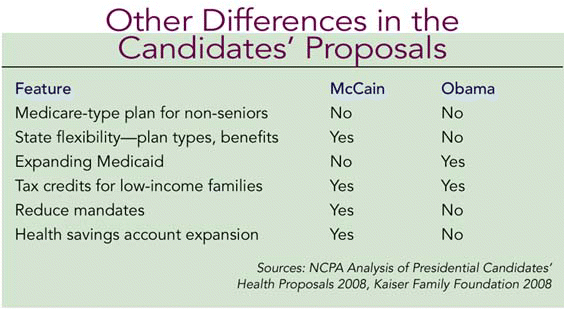Possible dealbreakers: Voluntary pools have failed to increase access, have not offered lower premiums, and are susceptible to adverse selection because individuals who would pay higher prices outside the pool enroll in the pool and drive up premiums, making them uncompetitive. Mandatory pools displace market-based products-for example, Massachusetts replaced the individual market with its Connector and may include small groups in the near future.
Explore This Issue
September 2008McCain: Would promote competition and individual choices by allowing insurance to be sold across state lines, encourage multiyear insurance products, allow small businesses and self-employed workers to purchase insurance through any organization or association. Such plans would have to meet standards and certification. Coverage would be portable and would bridge the gap between retirement and Medicare eligibility.
Possible dealbreaker: Legislation would be required to allow insurers to sell insurance across state lines. Voluntary plans are susceptible to adverse selection; many people don’t enroll until they are sick. State mandates hinder insurers’ ability to offer affordable products to individuals and small groups.
High-Risk Pooling Mechanisms
McCain: Insure five million high-risk people by expanding federal support for the 34 existing high-risk pools, use market-based initiatives to encourage other states to create such pools, or create a federal pool to help states cover the 40% of the cost not covered by private insurance premiums. Offer states incentives to subsidize individuals who qualify but cannot afford the premiums.
Possible dealbreaker: Currently only 207,000 individuals are enrolled in such plans. Creating a federal safety net could cost billions.
Obama: Require insurers to accept all applicants, regardless of their health (guaranteed issue).
Possible dealbreaker: Of 16 states with guaranteed issue, 11 are among those with the highest average health care expenditures per capita, $6569 versus $4425 for states without guaranteed issue. When insurers are kept from pricing predicted risk appropriately and matching their policy configurations to market demands, they resort to higher uniform prices, risk avoidance and market exit. (National Association of State Comprehensive Health Insurance Plans, Nov. 15, 2007)
Summing up, Michael Ehlert, MD, a urologist and former president of the American Medical Student Association, takes a pragmatic approach to health care reform. Things aren’t really bad enough for most people to accept change. For employees, things are great. Most professional organizations aren’t taking a stand, and Joe Sixpack without insurance doesn’t impact everyone. Also, having health insurance doesn’t equate to getting health care. Mandating coverage doesn’t mean there will be a subspecialist ready to see you when you want.
Who Are the Uninsured?
Any plan to expand the number of Americans, legal and illegal residents included, with health insurance must take into account who they are and why they do not have insurance:
- 46.58 million uninsured
- 75% live in FL, TX, CA, NY, and IL
- 9.5 million illegal immigrants
- 8.3 million earn $50,000-$75,000
- 8.74 million earn $75,000+
- 5 million medically uninsurable
- 9.3 million uninsured children-68% eligible for Medicaid and/or SCHIP
- Approximately 10 million uninsured for 4 months or less
Sources: Census Bureau 2005; American Academy of Pediatrics 2006
National Health Insurance Exchange: ‘The Connector’
Massachusetts is the only state thus far to have adopted a Connector, enrolling 340,000 newly insured state residents. However, there are widespread shortages of physicians to treat them, the program is underfunded by $150 million to $200 million, and many eligible for insurance have opted to pay a $219 per person tax penalty rather than enroll. In 2009, the penalty will climb to a maximum of $912. The Connector has allocated nearly 10% of next year’s $39 million budget to handle the 8000 appeals it expects from higher penalties.

Leave a Reply